Facts about Transistors
Posted by Admin / in Science Facts
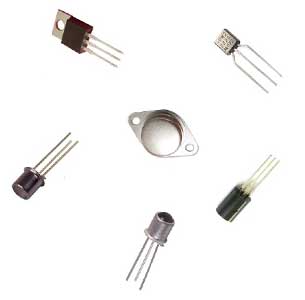
Different types of transistors
The History of Transistors
- Discovery of the transistor probably began when Thomas Edison discovered the light bulb in 1879.
- in 1897, the scientist who also discovered the electron, Joseph John Thompson, published his discovery of the cathode ray tube, which was based on Edison's light bulb.
- In 1906 an scientist named Lee De Forest refined Thompson's cathode ray tube creating the triode vacuum tube which allowed a new level of electronics to be created because it has a third electrode allowing electronic on-off switches, based on logic.
- In the early part of the 1900's vacuum tubes were used to make more and more elaborate electronic circuits. Use of vacuum tubes soon became limited because of their large size, short life span, slow speed and large amount of power needed for circuits with a large amount of vacuum tubes.
- The development of the transistor was extremely important to increase development of small electronic devices and circuits that involve logic.
- In the 1930's scientists at Bell Labs in New Jersey began to develop electronics known as solid state electronics. At the time most electronics were built with vacuum tubes. Vacuum tubes were used to amplify current or act as a one-way valve. The push for solid state electronics was to develop smaller, more reliable electronics that were made only from solid materials.
- In 1947 John Bardeen, Walter Brattain and William Shockley from Bell Labs developed the first solid state transistor. The first transistor featured three contact points and was made from Germanium.
- By 1954 Texas Instruments developed the first transistor made from silicon.
- Even as improvements were made to circuits with a individual soldered transistors, size limitation soon became an issue with complex circuits
- In 1958-59 Jack Kilby and Robert Noyce invented the integrated circuit which is a single chip with multiple transistors or other components like resistors.
- There are many companies that were created prospered as a result of invention of the transistor.
- Chip makers have used transistors to make their chips much faster. The first computer chips in the early 1970's had several thousand transistors on each chip to perform calculations. Chip designers have been able to make transistors smaller and smaller to include more transistors on each CPU to perform calculations faster.
- The original Pentium processor released by Intel in 1992-1993 contained over 3 million transistors.
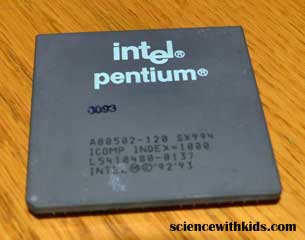
The original Pentium CPU has over 3,000,000 transistors.
Using a Transistor in a Circuit
- A transistor is a semiconductor electronic component, typically made from silicon or germanium.
- A transistor has three leads which allows it to act as an amplifier or a switch.
- Transistors have 3 leads including a base lead, collector lead and emitter lead. Some types of resistors such as the FET refer to these leads as the drain lead, gate lead and source lead.
- One lead of the transistor can be controlled by a low-level voltage (signal) to control flow of a much greater current through the other two leads.
- Transistors are rated by their manufacturer for maximum power dissipations, collector-base voltage, collector-emitter voltage, emitter-base voltage, Breakdown voltage and transition frequency.
- Some transistors can be used as gates. When the supply voltage is high enough, flow of current is triggered through the other two leads.
- Some transistors can vary the amount of current through the transistor instead of turning it off or on.
- Modern computer processors use many micro-size transistors to be able to perform so many calculations. As of 2015, the most current Intel processor has over 5.5 billion transistors
- Each type of transistor listed below has more than one use in an electronic circuit.
Types of Transistors
- There are two different categories of transistors, including bipolar and field-effect (FET) transistors.
- Transistors have many different uses, from electronics switches to becoming part of a powerful computer processor. Here are some different types of transistors including what they may be used for in a circuit.
- Power transistor - Power transistors are used to make high-power amplifiers and power supplies.
- Small signal transistor - Small signal transistors are used in circuits to amplify low level signals. This is useful in amplifiers, medical equipment and measuring devices.
- Switching transistor - Switching transistors operate fully off or fully on. Switching transistors are used in designs for power supplies, electronic switches and automation equipment.
- Phototransistor - Since transistors are made from semiconductive material grown into crystals such as germanium or silicon, all transistors react to light. The most commonly used phototransistors is an NPN transistor. Solar cells are actually a type of phototransistor.
- Darlington transistors are a special type of transistor that has two transistors joined together. They are very useful for amplification and used to make pre-amplifiers for audio.
- High Frequency Transistor - Since these types of transistors are used in the high frequency range, they are used for radios, communication equipment, television signal and microwaves.
- Unijunction Transistor (UFT) Unijunction transistors are used to direct voltage in a circuit -
- Field-Effect Transistors (FET) are a very useful type of transistor since they can adjust resistance through the amount of voltage introduced to the transistor. FETs are also used to make amplifiers, dimmers and digital switches.
- Metal-Oxide semiconductor FET (MOSFET) is a transistor that is very important for logic circuit boards and computers.
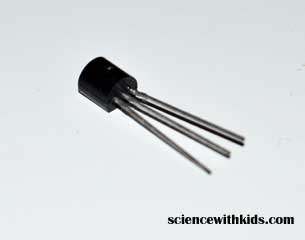
The 2SC945 NPN Transistor is a small signal transistor that is used for amplification and switching circuits.
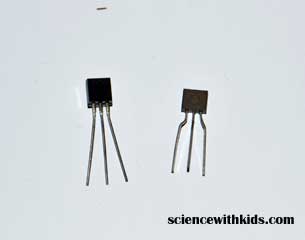
The 2N3906 PNP Transistor is a switching transistor that is used for amplifier and switching circuits.
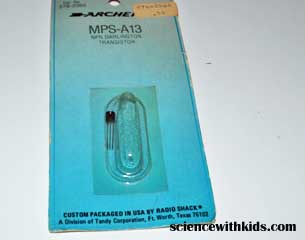
Darlington Transistor
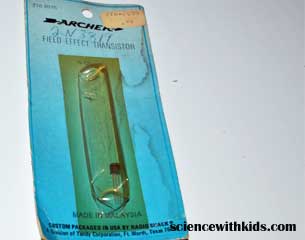
Field Effect (FET) Transistor
